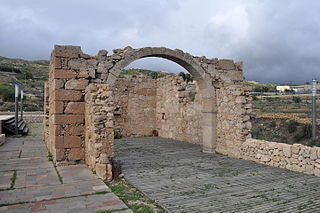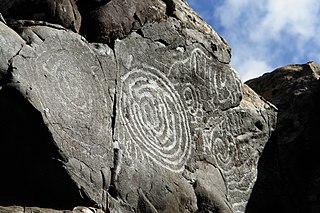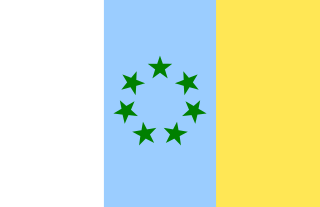Related Research Articles

The Canary Islands, also known informally as the Canaries, are a Spanish autonomous community and archipelago in Macaronesia in the Atlantic Ocean. At their closest point to the African mainland, they are 100 kilometres west of Morocco and the Western Sahara. They are the southernmost of the autonomous communities of Spain. The islands have a population of 2.2 million people and are the most populous special territory of the European Union.

The Guanche were the historic indigenous inhabitants of the Canary Islands in the Atlantic Ocean some 100 kilometres (60 mi) west of the North African coast. They spoke the Guanche language. Believed to have been related to Berber languages of North Africa, it became extinct in the 17th century after the islands were colonized.

La Gomera is one of Spain's Canary Islands, in the Atlantic Ocean off the coast of Africa. With an area of 370.03 km2 (142.87 sq mi), it is the third-smallest of the archipelago's eight main islands. It belongs to the province of Santa Cruz de Tenerife. La Gomera is the third least populous of the eight main Canary Islands, with 22,361 inhabitants at the start of 2023. Its capital is San Sebastián de La Gomera, where the cabildo insular is located.

Gofio is a sort of Canarian flour made from roasted grains or other starchy plants, some varieties containing a little added salt. Gofio has been an important ingredient in Canarian cooking for some time, and Canarian emigrants have spread its use to the Caribbean and the Western Sahara. There are various ways to use it, such as kneading, dissolving in soup, and baking. It can also be used as a thickener. It is also found in Argentina, Uruguay, and Chile, where it is known as harina tostada and is employed in a wide variety of recipes. The gofio commercially available in the Canary Islands is always finely ground, like ordinary flour, despite the definition given in the Spanish Dictionary of the Royal Academy.

Fasnia is a town and a municipality in the eastern part of the Spanish island of Tenerife, one of the Canary Islands, and part of the province of Santa Cruz de Tenerife. The municipality extends for 45.1 square kilometers (17.4 sq mi) from the mountainous interior to the beaches on the Atlantic. Its population is 2,873 (2013). The TF-1 motorway passes through the municipality.
Isleños are the descendants of Canarian settlers and immigrants to present-day Louisiana, Puerto Rico, Texas, Cuba, the Dominican Republic, Venezuela, and other parts of the Americas. In these places, the name isleño was applied to the Canary Islanders to distinguish them from Spanish mainlanders known as "peninsulars". Formerly used for the general category of people, it now refers to the specific cultural identity of Canary Islanders or their descendants throughout Latin America and in Louisiana, where they are still called isleños. Another name for Canary Islander in English is "Canarian." In Spanish, an alternative is canario or isleño canario.

The Canary Islands have been known since antiquity. Until the Spanish colonization between 1402 and 1496, the Canaries were populated by an indigenous population, whose origin was Amazigh from North Africa.

The Movement for the Self-Determination and Independence of the Canary Islands, was an independentist organization and socialist nature, founded in 1964 by Antonio Cubillo, whose objective was the secession of the Canary Islands from Spain. During the 1970s it operated through two terrorist groups: the Guanche Armed Forces (FAG) and the Canarian Armed Detachments (DAC), directly, but unintentionally causing one death, and indirectly causing 583 deaths and 61 injuries. It maintained good relations with other groups terrorists, mainly First of October Anti-Fascist Resistance Groups (GRAPO), who provided it with weapons and explosives, and with socialist Arab governments, such as Libya and Algeria, which provided financing and in Algiers they had a radio station. Also MPAIAC radio programs asked the Canarian people to "return to their roots" and tried to popularize the Berber language.
Canary Islanders, or Canarians, are the people of the Canary Islands, an autonomous community of Spain near the coast of northwest Africa. The distinctive variety of the Spanish language spoken in the region is known as habla canaria or the (dialecto) canario. The Canarians, and their descendants, played a major role during the conquest, colonization, and eventual independence movements of various countries in Latin America. Their ethnic and cultural presence is most palpable in the countries of Uruguay, Venezuela, Cuba and the Dominican Republic as well as the U.S. territory of Puerto Rico.

Canarian Spanish or Canary Island Spanish is a variant of standard Spanish spoken in the Canary Islands by the Canary Islanders.

Canarian nationalism is a political movement that encourages the national consciousness of the Canarian people. The term includes several ideological trends, ranging from a demand for further autonomy within Spain to the right to self-determination.

The Guanche Armed Forces was the armed wing of the Movement for the Self- Determination and Independence of the Canarian Archipelago, Spanish: Movimiento por la Autodeterminación e Independencia del Archipiélago Canario(MPAIAC). It was active between 1 November 1976 and late 1978, when the group unilaterally announced a "ceasefire" in what it considered to be "struggle against Spanish colonial occupation" of the Canary Islands.

Guanche mummies are the intentionally desiccated remains of members of the indigenous Berber Guanche people of the Tenerife. The Guanche mummies were made during the eras prior to Spanish settlement of the area in the 15th century. The methods of embalming are similar to those that were used by the Ancient Egyptians, though fewer mummies remain from the Guanche due to looting and desecration.

The conquest of the Canary Islands by the Crown of Castile took place between 1402 and 1496 and described as the first instance of European settler colonialism in Africa. It can be divided into two periods: the Conquista señorial, carried out by Castilian nobility in exchange for a covenant of allegiance to the crown, and the Conquista realenga, carried out by the Spanish crown itself, during the reign of the Catholic Monarchs.

The Church of the Guanche People is a religious organisation, founded in 2001 in the city of San Cristóbal de La Laguna, Tenerife, Canary Islands, Spain. Its goal is to revive and spread the traditional religion of the indigenous Guanche people who occupied the islands at the time of Castillian conquest.
Pintaderas are a form of stamp used by the pre-Hispanic natives of the Canary Islands. They were commonly made of fired clay. However, a number of wooden pintaderas have also been found. Most pintaderas come from archaeological sites in Gran Canaria, although natives from other islands in the Canarian archipelago used them too. Pintaderas were usually decorated with ornate geometric shapes, including zigzags, triangles, rectangles, squares and circles. These decorative motifs are similar to those found on pre-Hispanic Canarian pottery. Similar geometric patterns can also be seen in pre-Hispanic Canarian rock art
As in the rest of Spain, the majority religion in the Canary Islands is the Catholic Church. The Catholic religion has been the majority since the Conquest of the Canary Islands in the fifteenth century. This religion would largely replace the Canarian aboriginal religion through the prohibition of the latter and syncretism. According to a survey conducted in 2019, Canary Islands is the fifth autonomous community in Spain with the highest percentage of people who declare themselves to be Catholics after the Region of Murcia, Extremadura, Galicia, Aragon, and Castile and León. 76.7% of the population is Catholic.

El Museo Canario is an archeological museum in Las Palmas, the capital city of Gran Canaria in the Canary Islands. It is dedicated to the pre-colonial history of the Canary Islands.
Secundino Delgado Rodríguez was a Canarian politician, considered by some to be the father of Canarian nationalism.

Roque Bentayga is a rock formation on the island of Gran Canaria. It is located within the volcanic caldera of Tejeda, in the municipality of the same name, in the heart of the island. Roque Bentayga is considered an archaeological monument because it contains an "almogarén".
References
- 1 2 Maarten Kossmann, Berber subclassification (preliminary version), Leiden (2011)
- ↑ Richard Hayward, 2000, "Afroasiatic", in Heine & Nurse eds, African Languages, Cambridge University Press
- ↑ Andrew Dalby, Dictionary of Languages, 1998, p. 88 "Guanche, indigenous language of the Canary Islands, is generally thought to have been a Berber language."
- ↑ Bynon J., "The contribution of linguistics to history in the field of Berber studies." In: Dalby D, (editor) Language and history in Africa New York: Africana Publishing Corporation, 1970, p 64-77.
- 1 2 Militarev, Alexander (2018). "Libyo-Berbers-Tuaregs-Canarians (Tamâhaq Tuaregs in the Canary Islands in the Context of Ethno-Linguistic Prehistory of Libyo-Berbers: Linguistic and Inscriptional Evidence)". Research Gate.
- ↑ Chisholm, Hugh, ed. (1911). . Encyclopædia Britannica . Vol. 12 (11th ed.). Cambridge University Press. pp. 650–651, line two.
....man of Teneriffe," corrupted, according to Nuñez de la Peña, by Spaniards into Guanchos
- ↑
 This article incorporates text from this source, which is in the public domain : Espinosa, Alonso de; Markham, Clements Robert (ed.). 1907. The Guanches of Tenerife, the holy image of Our Lady of Candelaria, and the Spanish conquest and settlement . (Works issued by the Hakluyt Society, second series, 21.) London: Hakluyt Society . 229pp.
This article incorporates text from this source, which is in the public domain : Espinosa, Alonso de; Markham, Clements Robert (ed.). 1907. The Guanches of Tenerife, the holy image of Our Lady of Candelaria, and the Spanish conquest and settlement . (Works issued by the Hakluyt Society, second series, 21.) London: Hakluyt Society . 229pp. - ↑ Reyes, Ignacio (2017-09-14). "Guan". DICCIONARIO ÍNSULOAMAZIQ (in Spanish). Retrieved 2021-11-26.
- ↑ Wölfel, Dominik Josef. 1965. Monumenta linguae Canariae: Die kanarischen Sprachdenkmäler. Graz, Austria: Akademische Druck- und Verlagsanstalt.